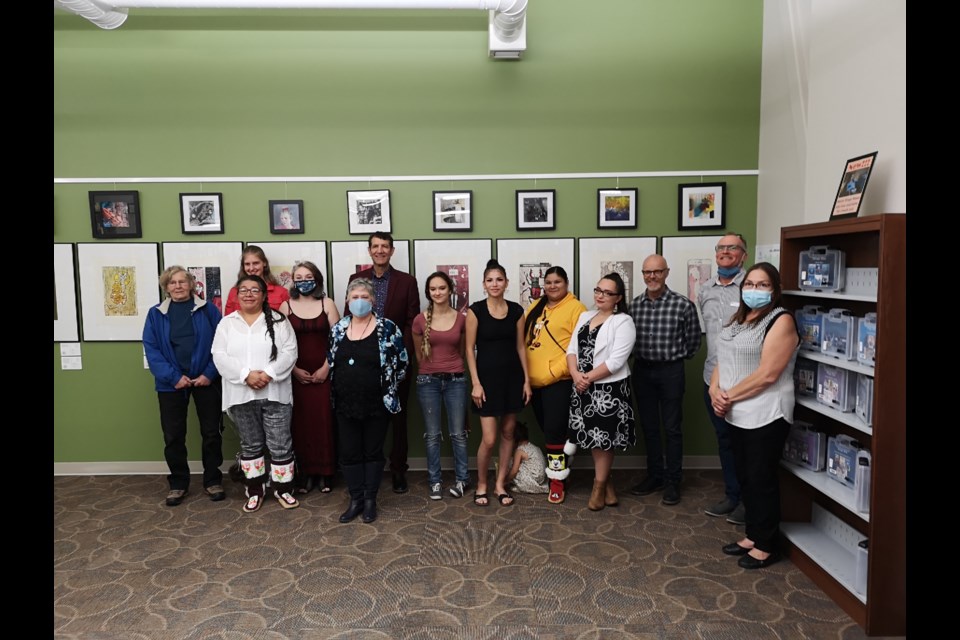LAC LA BICHE — Over the past three months, from June 2 to Aug. 27, the Stuart MacPherson Public Library featured 60 bodies of work capturing the intense emotions that living through a pandemic has generated and the anticipated relief that is craved when public health concerns and restrictions finally recede.
The artwork displayed in the Time Stamps: The Art of Relief exhibition was created by students and instructors from Portage College, the University of Alberta and Sapporo Otani University in Japan.
To wrap up the local exhibit, roughly 40 individuals including the artists, instructors, members of the public and local dignitaries were in attendance at closing ceremony held on Aug. 27 in the public library.
According to Maureen Penn, the library’s director, more than 106 people visited the exhibit during the summer months, several visitors left comment cards describing the impact of the artists’ creations.
“Tremendous exhibit, such a variety and such talent,” one read. Another comment card reading “Wow, with the way of life since the pandemic began it's very interesting how it was captured through art. I enjoyed the exhibit.”
The exhibit’s concept came about after Portage College’s Fine Arts Instructor Pierre Öberg listened to a CBC radio interview with Jill Lepore, a professor of American History at Harvard University, where they compared the current COVID-19 pandemic with the polio epidemic that disproportionality effected small children and youth.
For Öberg, expressing a health crisis through an artistic lens is one way of capturing a period of history that can be more universally understood while remaining timeless.
“In hopefully a small way, in a small gesture, this period of time has been captured in a way that can inform future generations if there are similar struggles, but also inspire and comfort future generations that may have to go through similar challenges,” he said, adding that its common for generations to look back in time to find similar works of art created throughout periods of global turmoil and disease outbreaks such as polio.
“We forget about it until we need to be reminded and maybe comforted by other generations to say, ‘OK, we've been through this before as a global family and we can get through it again.’ I think we can find strength and hope and courage and faith in previous generations.”
Capturing a moment in time
Describing the elements of the interview that sparked the idea for the international and multi-generational collaboration, Öberg said, “When the Salk vaccine in the 1950s came to be, it was a real time stamp for people of that generation because polio had been around for a long time... (Lepore) talked about how there was such a sense of relief. It was those two words that really triggered the imagination, because “stamping” is something that we do in various studios and “relief” is one of those art terms that can be applied to a lot of different art-making practices from sculpture to printmaking.”
Using the two key words highlighted in the radio interview, Öberg designed and actualized the Time Stamp exhibit with the help of Professor Atsushi Okabe and Professor Yoshinori Kon from Sapporo Otani University, Professor Ruby Sweetman of the Native Cultural Arts Program at Portage College and Professor Marilene Oliver and Professor Royden Mills from the University of Alberta.
The coming together of the art installation was serendipitous Öberg says, “To get different cultural perspectives, provincial perspectives and regional perspectives — I think not only was it helpful, and maybe perhaps healing and comforting in some ways to the individual artists, but also because we could come together and share a conversation through artwork.”
With such a wide array of contributors to the art show, Öberg believes there was an opportunity for everyone to connect in a visual way to at least one of the pieces, as some were poignant, some subtle and others had a dash of humour.
“The ‘voice through visual’ form that artists bring can sometimes awaken a perspective or a feeling in ourselves that can help us through the current challenges that we're having... some people prefer to go to a book, some people prefer to go to an artwork,” he stated.
COVID delays
The series took over a year to bring to fruition starting shortly after the first lockdown, the idea behind the project began gaining traction in June of 2020.
“It was interesting because this was a COVID show and the library, following provincial guidelines, was closed and then reopened and then closed and reopened a number of times. So, we were actually experiencing a delay of when the opening and the closing celebration would be in real time,” said Öberg, adding that the library generously allowed the display to be extended until the facility was fully open to the public.
The closing ceremony corresponded with a rising number of COVID-19 cases in the Lakeland region and across Alberta, being referred to as the beginning of a Fourth Wave. Although it was not mandated at the time, several guests chose to wear a protective mask during the event. Catered food for those invited was individually packaged.
“I kept thinking, ‘Wow, this is a show about COVID, and COVID is actually dictating how this show will roll out and when the celebration will happen, ’” Öberg told Lakeland This Week.
Along with comments from local dignitaries, a video letter sent by Sapporo Otani University professor Kon was played during the evening event.
Archive copies
Although the exhibit will not appear again in its complete collection at any other location, it has been archived in a digital format. A ‘box-set’ containing postcard-sized reproductions of all 60 art pieces — and additional material — is also available for viewing at the library, Portage College, the U of A and the Japanese university.
Replicas of the work may be viewed upon request within these facilities.



